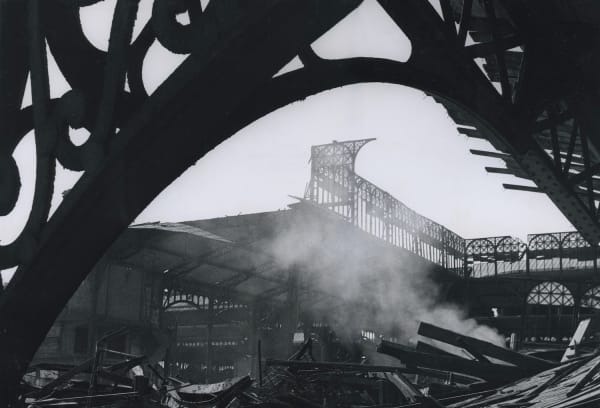Jean-Claude Gautrand: Baltard’s Murder
Les Douches la galerie is pleased to present, for the first time, fifteen prints from the famous photographic series taken in 1971 by Jean-Claude Gautrand: Baltard’s Murder.
-

Au cœur de la conscience de Romain Urhausen
Lucie Guillet, Fisheye, 17 May 2023 -

C’était les Halles
Frédérique Chapuis, Télérama Sortir, 10 May 2023 This link opens in a new tab. -

Jean-Claude Gautrand
Christine Coste, L’œil, 23 April 2023 This link opens in a new tab. -

Jean-Claude Gautrand : L’assassinat de Baltard à Les Douches la Galerie
Blind, 20 April 2023
Throughout his life, the French photographer Jean-Claude Gautrand has used his photographs and texts to document what is no longer there, what is destined to disappear. Born in 1932 in the North of France, he seldom travelled. He photographed mostly Paris and its changes, and he became interested in places that bear the stamp of History: the sacrificed village Oradour sur Glane, the Struthof concentration camp, the end of the mining district, the blockhouses on the Atlantic coast...
‘Baltard’s Murder’ immortalised the destruction of the architect Baltard’s immense les Halles marketplace in the heart of the capital whose glass and iron structures disappeared in the dust and light of the summer. Gautrand is the only photographer who followed the entire process of destruction. Can you imagine the Prefect of Paris authorising the demolition of the Grand Palais?! And yet a similar drama unfolded in the heat of August 1971. Despite many protests and demonstrations by Paris’ inhabitants. Twelve halls, designed by the architect Victor Baltard in 1856, made up of iron structures topped by glass canopies, were set to be razed. Those treasures of 19th century industrial architecture housed a gigantic wholesale market in the centre of Paris. The famous les Halles lent their name to the neighbourhood that Emile Zola called ‘The Belly of Paris’. The market was subsequently moved to la Villette and Rungis. Jean-Claude Gautrand followed the entire procedure, from the demolition of the first halls to the reconstruction of Pavillon Baltard in Nogent-sur-Marne. Using a Rolleiflex and black and white film, he showed up every day, bypassing the no-access signs, climbing on rooftops to document what he called ‘Baltard’s Murder’.
His photographic documentation became a book published by Éditions Formule 13 in 1972, winning the city of Arles’ Grand Prix du Livre the same year. In the early noughties, Martin Parr and Gerry Badger included it in the volume devoted to Protest books in the series Le Livre de photographies : une histoire [The Book of Photographs - A History], which has become a sort of Bible for fans of photography books.
Sylvie Hugues
Curator
KEY DATES IN THE DESTRUCTION OF BALTARD’S HALLES
1969 : The market is moved to Rungis and La Villette between 27 February and 1 March. At the time, the operation is considered ‘the move of the century’, involving 20,000 people, 1,000 wholesalers, 10,000 cubic metres of materials, 5,000 tonnes of merchandise and 1,500 lorries. In March, the Rungis market opens its doors.
1970 : The depleted Halles neighbourhood begins to take on life again through intense cultural activity: theatre, exhibitions, dance. Béjart performs there; an exhibition of Picasso’s works is put on; the opera Orlando Furioso is a resounding success.
1971 : The first six halls located on the eastern side of rue Baltard are demolished to make way for an RER station and for the Forum.
1973 : The meat halls, the south blocks of les Halles and the Beaubourg blocks are razed. Only one of the halls is preserved, number 8, which houses the poultry and egg market. It is dismantled and rebuilt in Nogent-sur-Marne and becomes the Pavillon Baltard concert hall. The building materials for the rest of the halls will be sold as scrap metal.
1974 : Newly-elected President Valéry Giscard d’Estaing decides to abandon the international business centre and creates a garden in its place.
1975 : The plan that Paris’ residents have selected is rejected in favour of one proposed by the architect Ricardo Bofill, which is subsequently discarded for Jean Willerval’s plan. The shopping centre named Le Forum is designed by the architect Claude Vasconi.
2016 : Jean Willerval’s structures are demolished to make way for la Canopée, the new centre of les Halles.






